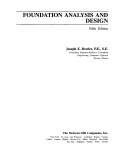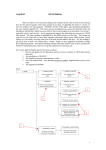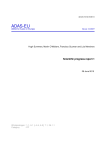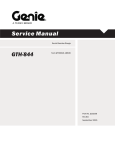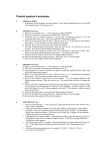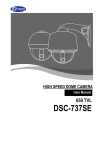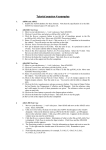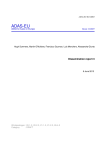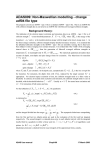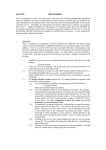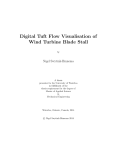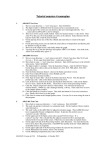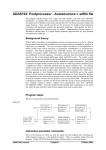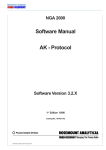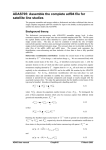Download Bulletin for ADAS v2.8
Transcript
Nov18-04 ADAS Bulletin Items: 1. 2. 3. 4. 5. 1. ADAS release v2.8 ADAS development and release plans for 2005. The next ADAS work-in at Strathclyde. The 2005 ADAS workshop. Code and data updates in release v2.8. ADAS release v2.8. At this release, we have implemented a number of structural changes which were perhaps overdue. These include converting ADAS archiving and version control to CVS; implementing MATLAB access to key ADAS data formats and updating the website. You will recall that at the inception of the ADAS Project, code version control was placed under SCCS. Then about three years ago, we also placed the database under SCCS. Under SCCS, the release mechanism was fairly slow. Also, we have a somewhat changed situation now in that we have both Martin O’Mullane and Allan Whiteford implementing and overseeing ADAS code development and this takes place partly at UKAEA/JET and partly at the University of Strathclyde. Martin and Allan have felt for some time that CVS would handle the ADAS needs better and it is now pretty universal. So Martin and Allan put in a substantial effort two months ago to make the change over and took the opportunity to do some desirable tidying up and relocation of certain items at the same time. We have tested on two or three sites and so with this release we make the full change over. Although all of us function under IDL to some extent, at one or two sites, especially Cadarache, MATLAB is the preferred graphic language. The main need is really an ability to access the main ADAS data formats via MATLAB procedure calls – a capability we have already implemented for IDL and C. The primary access subroutines (and complete set) in ADAS are in fact FORTRAN subroutines, mostly with names such as bxdata.for, cxdata.for (for the ADAS series specific access) and names such as xxdata_04.for (for complete data set capture). Most matching IDL access procedures, which have names like read_adf11.pro in fact use the FORTRAN subroutines – mediated through C for parameter passing and checking. Paul Thomas took the lead on this and prepared the first two MATLAB procedures. Martin has now adjusted these slightly to fit into the ADAS library structure and has added to the available set, which now includes adf02, adf07, adf11, adf13 and adf15. Details are in section 5 (C20). I am afraid that the ADAS website has been showing some signs of neglect. In fact there are two ADAS websites, the open one which we maintain from Strathclyde and then an internal one at the JET Facility which is maintained by Martin. The Strathclyde website also functions as part of our Departmental profile. They have grown apart. Latterly more attention has gone into the JET webpages with material which in fact would be useful to all of us. As Allan is now handling ADAS maintenance and development under Martin’s overall guidance, we have a chance to rationalise. So we have brought up the revised webpages for ADAS which now parallels the JET one closely. There are more pages to complete still, but we have put the material which is ready up anyway in time for this release. 2. ADAS development and release plans for 2005. Because of the various structural changes implemented this release, we have held off including the substantial new data sets and physics codes which we have been working on. Our intention is for the next release to be towards the end of February 2005 and at that time, we shall release the rest of the heavy species handling (flexible partitions etc) and the extensive data for the heavy species we have been dealing with (including xenon, tungsten and tin). Also we shall release the complete handling for non-Maxwellians. The full version of ADAS809 (which includes numerical non-Maxwellian distributions) is released now but the rest of the handling through effective coefficients, population structure and line ratios has still to come. With the heavy species, it has been very helpful – if testing! – to have been interacting closely with Thomas Kruecken and Thomas Putterich during the development. Because they have had clear ideas of what they wanted and of when things did not look right or needed explanation, it has provided a strong impetus to us – and the development of such complicated models is by no means trivial or free of angst. I should have liked a partner for the non-Maxwellian code use and testing - if possible now, so that more hardening can be in place by the end of February. Is anyone 1 out there interested? Also in February, we shall release the first cut at the series 3 Stark population and feature component code ADAS305. This was brought into play two or three months ago by Martin and Sanjay. Turning to 2005 development, I think our focus must be mostly on charge exchange and on special features. As you know Allan is working with Manfred von Hellermann, Lorne Horton and Klaus-Dieter Zastrow to bring up revised versions of KS4FIT and CHEAP. This is a major commitment, which is very important for charge exchange spectroscopy with heavier species such as argon and upwards, and will be paralleled with experiments at IPP Garching, MAST and JET. From a theoretical atomic physics point of view, it requires a new intermediate coupling [(Jp)nlj] population code, which I see as a code common to charge exchange and to the next level of heavy species population modelling. This is moving along quite well but there is still a lot of work. We shall take in a revision/update of the beam modelling codes and of the underlying data as part of overall development. Martin and Michael Proschek have being working on this (really bringing codes, neglected since Harvey Anderson’s departure, back into the light of day). From an astrophysical point-of-view, we are also overdue on bringing Nigel’s photo-excitation photo-excitation data (which is archived under ADAS formats adf38 and adf39) into effective use. This is connected with Mike Seaton and Nigel’s opacity modelling which we we plan to access also through ADAS. We have also to complete work on hydrogen, hydrogen spectral series and series limits. The new ionisation data is available and we have the high grade excitation cross-section calculations from two or three years ago. But I want to complete adf04 type 1 files for hydrogen as we have done for helium (including the .err file) and so there is a bit of recalculating required. Then we can run through the population, ionisation, line emission, line broadening and series limit modelling from that. Sheena Menmuir and Peter Stangeby are waiting for the results and they are severely overdue. Altogether it looks like a pretty full schedule again. 3. The next ADAS work-in at Strathclyde. We would like to hold the two week course on ADAS and Atomic Calculations at Strathclyde again in 2005. As for the first one, it will be intensive – every day over two weeks – with a series of lectures on ADAS and on the calculation of atomic structure and collision processes. We shall adjust how much of ADAS itself to put in depending on the wishes and needs of participants. The main objective will of course again be seeing through some specific studies in this area brought in by the participants and which will hopefully lead to joint publications. Departmental and ADAS staff (Nigel Badnell, Allan Whiteford, Mike Witthoeft, Martin O’Mullane and I shall be present ). Participants at this time include Alessandro Lanzafame and Adam Foster. We shall work on GCR modelling of magnesium. It would perhaps be nice to deal similarly with argon and/or iron. Anyone interested? It is important that we decide soon on dates, since it has to fit in with University teaching duties. At the moment, we are moving towards an April slot. Please let me know as soon as possible if you or any of your colleagues would like to participate and send me your preferred dates. As on previous occasions, there will be no charge, but participants are responsible for their own travel and accommodations costs. 4. The 2005 ADAS workshop. The 2005 ADAS Workshop will again be at Cadarache. The provisional dates are 19-20 Sept. 2005. As usual this means arriving at Cadarache on the afternoon/evening of Sunday 18 Sept. and departing on the afternoon of Tuesday 20 Sept. Please let me know if these dates cause a clash with other major meetings. 5. Code and data updates in v2.8. Corrections and additions to codes (ADAS v2.7.1 to ADAS v2.8) C.1 To cope with elements up to Pb ADAS405 and ADAS406 required an internal dimension to be increased. IZDIMD was increase in 2001 but ISDIMD was missed. We also need a strategy for deciding how many metastables will be permitted - the implicit assumption here is that IZDIMD = ISDIMD for the heavier atoms. 2 C.2 ADAS304 can interrogate both adf21 (beam stopping) and adf22 (beam emission) coefficient files. To ensure the correct y axis label on the plot the program needs to know which it has. Unfortunately the logic to determine this did not work if only one impurity was selected. The data plotted was correct but the label was misleading. There was more then one user interface problem with ADAS304. The beam energies are archived in the adf21 (and adf22) files in eV/amu. Somewhat unfortunately, the program asks for, displays on the graph and outputs in the paper.txt file these energies in eV. As no beam mass was asked for the program operated with the correct eV/amu - it just labeled it incorrectly. This has now been fixed. C.3 There are a number of improvements to ADAS804. Various errors have been corrected, the archive and standard output handling have been improved and calculation information is now documented in the output file. C.4 An IDL version of h4mxwl is provided. This routine converts electron impact collision strengths to Maxwell averaged collision strengths. C.5 In ADAS208 the check to avoid integrating over zeros in the input from the projection matrix can result in no valid points. This can cause an out of bounds error in the splining. A check to avoid the call in this case has been added. C.6 Minor logic correction in xxdtes.for. There was an incorrect redirection in an if statement when checking the Eissner pattern. No change in behaviour but the compilers are happier. C.7 A number of changes to ADAS408: - Up to 20 groups in the DR parameter list are now possible. Some tungsten ions exceeded the previous maximum of 15 groups. - An unecessary debug print statement has also been removed. - In the automatic branch the names of the two adf04 files are now written to screen to facilitate checking of any warning messages. - For the PLT parameterised power the exact and simple powers are matched at the midpoint temperature rather than the fourth one. This can skew the result badly if there are more than eight temperatures. C.8 Command line wrapper written for orbital.for. C.9 IDL call to wig3j.for added via shared object library. C.10 read_adf02 failed if more than 24 data points were requested. Also the splining routine returned the wrong name in its error message, which could cause confusion. C.11 Add two checks to the run_adas8#1 script. The number of electrons in each configuration are tested to check if they are the same for all. If not the run stops. This can go wrong because the Cowan code uses, ocassionally, complex rules to build up the full configuration based on noble gas cores. A second test to determine whether the radial solution has converged is added. Again the run stops if it has not. C.12 The ADAS8#1 offline_adas code has been brought into synch with the central ADAS versions of ADAS801 and ADAS810. Some changed to the parameters has also been introduced. C.13 In ADAS313 an error would occur if a non-standard adf26 file name was used. The standard name, eg bdn97#h_be4.dat, was interrogated to provide impurity and beam information on the processing screen. This is not crucial for the calculation so this step is bypassed for nonstandard names and an appropriate message is displayed instead. 3 C.14 The supphe1 routine in ADAS311 didn't declare the TITLX variable, this resulted in architecture dependent errors when getting ionisation data from adf07 files. C.15 Plotting to a postscript file from the `retain' option present in series 5 programs did not work the code used a colour of white, which is fine for plots on a black background (i.e. the screen) but not for a white background (i.e. a piece of paper). C.16 Two new IDL utility routines: - adas_readfile.pro, which reads a text file into a string array. - adas_vector.pro, a function which generates a 1-D vector given lower and upper limits and number of points. The spacing can either be linear or logarithmic. C.17 A new IDL read_adf26.pro routine which reads in adf26 bundle-n (for H beams) and bundlenl (for He beams) populations. This version only returns the data in the file as a structure. The ability to select and interpolate specific parts may be introduced later. C.18 In the IDL routine, read_adf04.pro, the 'all' output structure has been renamed 'fulldata'. This is to provide consistency across the read_adfXX routines where the keyword /all is used to return requested data as a 2D function of Te and Ne rather than as a vector of (Te, Ne) pairs. A new /help keyword has been introduced which prints usage information to the screen. C.19 Fix to xxpars where a memory overun was occuring due to the writeback of cprta for a unified itype. Whilst memory was overun, it was a read of a few bytes which were part of unused code so no functionallity or results are affected. C.20 MATLAB support for accessing ADAS datasets has been added. These functions are analogues of the IDL read_adfXX routines and have the same names. For now the number of ADAS datatypes that can be read is limited to adf02, adf07, adf11, adf13 and adf15. However now that a structure is in place the others will follow. Type help read_adfXX (XX = 02, 07, 11, 13, 15) at the MATLAB prompt to see usage and required/optional inputs and outputs. The support of MATLAB is more limited than for IDL. The user will have to declare the path to these routines in order for MATLAB to find them. This can be done either by setting environment variables or with the addpath command. The location of the files is in …/adas/matlab (adas denotes the site dependent location of the adas account). With certain architectures (eg, Compaq Tru64) it will be necessary to include the location of the read_adfXX.so binaries as part of the LD_LIBRARY_PATH environment variable. If you have setup ADAS this will be the $ADASFORT directory. If not it is the …/adas/bin directory. C.21 New routines to read adf40, feature photon emissivity coefficient, files have been added. A new fortran routine, xxdata_40.for (and an xxdata_40.pro IDL version) can be used to read all the data in an adf40 file. The IDL read_adf40.pro routine can be used to interpolate the emissivities in temperature and density. Note that no interpolation is possible in wavelength. ADAS510 now uses these new routines to access the adf40 data. C.22 Added routines for evaluating special functions related to gamma functions (e.g. the incomplete gamma function). C.23 xxdata_37 has been added to the list of ADAS data format reading routines. This one reads a numerical electron distribution file – part of the non-Maxwellian modeling development. C.24 Upgraded ADAS809 to handle non-Maxwellians. A lot of work has gone into this by Paul Bryans. It is quite a big extension enabling numerical non-Maxwellians as well as the 4 Maxwellian, Druyvestyn and Kappa analytic forms. processing screen. The screen dump below shows the Select distribution Note that this code produces up and down coefficients for non-Maxwellians that is upsilons and downsilons for the electron impact excitation and ionization and three-body recombination scaled coefficients for the bound-free electron collisions. These appear as separate transition lines in the output adf04 type 4 file. Remember to delete your defaults file for this code before using the new version. Details of the extended operation will be placed in the ADAS User Manual. C.25 Updated xxdata_04 to handle more temperatures and also type 4 files. Dimensioning checks also changed. C.26 Added contraction of graph area in cw_adas_graph if the VERY_SMALL environment variable is set. C.27 Fixed bug in the output routine of ADAS208 where the filenames for the pec and sxb passing files could be appended with random data. Note this only affected the filenames, not the data produced. C.28 There are new routines and updates to code and data resulting from the beam modelling work, principally of Lorne Horton. xxdata_12.for replaces c3data.for as the preferred way of accessing adf12, the charge exchange effective emission coefficients. c3data will print a message to the screen advising that it has been deprecated. 5 A new routine, cxsqef.for has replaced the older sqef.for version. It evaluates Maxwell averaged effective rate coefficients using data in the adf12 datasets. An IDL version, cxsqef.pro is also available. Internal changes to read_adf21.pro make it more suitable to being called frequently. To increase speed the number of allowed requested plasma parameters accessible at one time has been increased by a factor of 10. The target ion fraction input has an extra dimension which allows for a varying ion fractions along the request vector. ADAS312 can now output the beam population coefficients. This is a new class of adf22 file which holds the population, relative to ground, of excited levels. The data arrangement is the same as the regular adf22 beam emission coefficients. Corrections and updates to data (ADAS v2.7.1 to ADAS v2.8) The larger than usual amount of trivial errors is due to the move from an SCCS to a CVS revision system. Considering the amount of data in ADAS the updates required represents a very tiny percentage. D.1 Hugh has updated the adf00 Kr file with ionisation potentials from NIST. The ionisation potential of neutral Xe has also been updated with the NIST value. D.2 Dario's N-like DR adf09 data for O+, Na4+ and P8+ was inadvertently missed on the last release. adf09 as well as adf27 (Na4+ and P8+) and adf28 (P8+ only) driver files are included. D.3 Mg-like adf04 data from Don Griffin has been updated. His October 2001 revision was missed. From the same paper the Ar6+ dataset was omitted also. This is now included. D.4 The configuration list in Hugh's 2002 version of He0 adf04 files has been changed into the standard type. D.5 Redundant files in the isoelectronic adf10 set have been removed. These were produced with ADAS204 and are not compatible with the ADAS208 versions. Note that these files were not used to generate the adf11 isonuclear data. The files were identifable by not having a pj (short for projection!) prefix. D.6 The 89 prc89_cr (power radiated due to charge exchange) had a small format error which prevented the fortran access routines from reading it properly. D.7 Add charge exchange cross section data from the ORNL 'redbooks' for H0 to the adf24 collection. D.8 Missed the B1+ adf27 driver file from James Colgan. D.9 Autostructure post processing driver files (adf28) for Ne-like DR were missing their final level/term (IC/LS versions). The final energy was missing from the O-like Ca12+, Cl19+, Mg4+ and Sc13+. D.10 Removed files from /.../adas/adf04/copsm#b/ which were prefixed with copsm_. Indexing was incorrect in the files which were removed, the same data are present (but with correct indexing) in the same directory. D.11 In /.../adas/adf04/helike/helike_hps02he_t1.dat, the 10-14 transition incorrectly had the same data as the 10-13 transition. The data were corrected by Iain Paton. 6 D.12 At high Z a fully relativistic solution for the atomic structure and collision problem becomes necessary. The Dirac atomic R-matrix code (DARC) is being piloted in the Ni-like system. Two adf04 files for Xe26+ and Ag19+ are in this ADAS release. D.13 Added neutral helium file adf04 type 3 from Connor Ballance, helike_cpb04he.dat. This is the pure R-matrix results from Connor’s very large calculations. The Maxwell averages are produced by the ADASEX offline code. D.14 Added neutral helium adf04 type 1 file from Iain Paton. These data are from the handworked adas_excel spread sheets. They are the assembled ADAS preferred data at this time and include the work above of Connor along with the various other sources – experimental and theoretical. Note that the adf04 .dat file has an accompanying .err file which is the assessed uncertainty of each entry in the .dat file. This comes from the spread sheet analysis. The .err file parallels the .dat file in organization and is designed to allow tracking of propagated error into derived atomic coefficients on into plasma models. D.15 Added neutral helium type 3 file from Paul Bryans. This is created from the adf04 type 1 file using the new ADAS809 code in its analytic Maxwellian mode of operation. HPS 18 Nov. 2004 7







